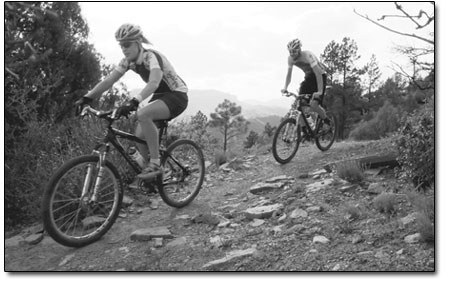| ||
A new Animas alternative
The Bureau of Land Management is hoping to meet the Durango public half-way on Animas Mountain. This week, the agency forwarded a compromise solution for mitigating wildfire hazard on the popular recreation area. Compromise aside, concerns still remain about the lingering costs of logging Animas Mountain. Following the catastrophic wildfire season of 2002 – which included Durango’s Missionary Ridge Fire – the Bush Administration created the National Fire Plan. Among the plan’s mandates was that the Forest Service and BLM thin trees in the Wildland Urban Interface, the edge of the forest near communities and homes. As incentive, the plan offered up a generous “use it or lose it” funding stream for such projects. In response, San Juan Forest and BLM lands in the vicinity of Durango have been aggressively treated in recent years. The local agencies use three approaches to curbing fire threat – prescribed burning, hand thinning and a relatively new practice known as hydromowing, where a large spinning drum with carbide teeth shreds small trees and brush. Hydromowing has been used extensively in the Grandview Ridge, Hermosa Creek and Hidden Valley areas but drawn mixed public reactions after each application. Early in 2007, the BLM announced that Animas Mountain would be the next area to go beneath the hydromower blade. Animas Mountain is among Durango’s most popular recreation areas for hiking, biking and climbing. However, the resource, which is part city park and predominantly BLM land, is also surrounded on three sides by homes and was identified in the La Plata County Community Fire Plan as an area of high concern and risk. Craig Goodell, the BLM’s project coordinator, noted, “Animas City Mountain is right in the wildland urban interface, and any large fire there could burn straight into Durango.” The BLM’s original plan entailed treating the mountain’s 850 acres exclusively with hydromowing. As first proposed, the project would have required reconstruction of an old road to create access for forestry equipment. However that old road is now a trail and makes up approximately half of the greater Animas Mountain loop. Potential damage to the recreational and natural resource incited strong public reactions and made for one the great controversies of 2007. This week the BLM offered a new approach to thinning Animas, when it released an exhaustive environmental assessment. Responding to concerns from 62 different individuals and organizations, the agency unveiled its “mini-mower” alternative, which proposes pairing a smaller hydromower with hand-thinning. “We certainly have heard what the public’s wants and desires are,” Goodell said. “But we also recognize the need to mitigate the fuels load up there. This is our attempt to strike a balance.” Under the “mini-mower” alternative, 100-foot corridors around trails would be hand-thinned. A smaller, Bobcat-sized hydromower would then thin the remainder of the mountain. Because of the smaller mower, no major road construction would be necessary and associated erosion issues would be eliminated. The agency would then rehabilitate any damage to the trail system. “We think that this combination will best meet the needs of the treatment up on the mountain while addressing the social concerns,” Goodell said. Social concerns remain, however. Mary Monroe, executive director of Trails 2000, said she appreciated the agency’s effort but that more would be needed. “It’s obvious they listened to public and decided to put a smaller mower up there and want to rehabilitate the road to the best of their ability,” she said. “But it looks to me like they could do more to address concerns and make this a better project.” Trails 2000 commented extensively on ways to improve the Animas Mountain trail system and eliminate the old road in question, which is considered unsustainable and a major erosion problem. However, in its environmental assessement the agency opted for the status quo. “We talked about other possible connection points, linking to the west side of the mountain and creating a more complete trail network up there,” Monroe said. “Ideally, you’d reroute it and build a new and better trail when the work was done. But they basically just want to put a band-aid on it.” Hydromowing – even with a mini-mower – also continues to mix opinions. Like Monroe, Katrina Blair, of Turtle Lake Refuge, gave a small nod to the BLM’s new plan but called for a lighter touch on Animas Mountain. “The mini-mower is a little better than the hydromower, but not by much,” Blair said. Blair noted that hydromowers thin indiscriminately, wiping out core, edible species in addition to dense oak and juniper stands. She added that the machines disturb the landscape and open the door to noxious weeds. Blair advocated defensible space around homes as a better approach to curbing wildfire threat. “I know they are trying to prevent fires,” she said. “But my feeling is that there are a lot of flaws to this one potential good.” The public still has an opportunity to weigh-in on the future of Animas Mountain. Though dates have not been announced, a public open house will be held at the San Juan Public Lands Center later this month. Other opportunities for public participation will also be scheduled. Monroe noted that Trails 2000 will continue to take part but that her expectations are not high. “We’ll continue to make comments and be a part of the process,” she said. “But I’ve never seen an environmental assessment come through where comments ended up creating significant change.” • The Animas Mountain Draft EA is available for review at: http: //www.fs.fed.us/r2/sanjuan/projects/projects.shtml.
|


